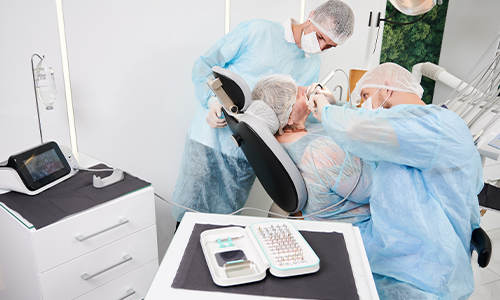What You Need To Know About Placement of Dental Implant?
Read the blog carefully to know the placement of dental implant and everything in detail.
Missing one or more teeth due to blunt-force trauma, an accident, or a dental extraction procedure can have many consequences. Lost teeth can alter the facial structure, misalign the bite, and affect the smile aesthetics. Fortunately, the gaps in the smile can be filled with many dental restoration options.
If you have been looking for a replacement for one or more missing teeth, you must consider placement of tooth implants -the metal posts that act as artificial roots of teeth and are surgically placed into the jawbone. These implants are held securely in the sockets of the missing teeth and serve as an anchor for replacement teeth which provides a complete smile. Replacement teeth can be dental crowns, bridgework, or even dentures that are plugged right atop the metal stud with a metal connector (or abutment) in between. Dental implants resemble natural teeth in looks, feel, and function.
Generally, dental implants procedure may be the right dental restoration solution for people having lost one or more teeth with sufficient jawbone to secure the implant or be able to have a bone graft. The candidates who wish to go ahead with this dental procedure must have healthy oral tissues and no underlying medical conditions affecting bone healing. They must not be smokers. People who prefer dental implants are the ones who wish to improve their speech and smile aesthetics, do not wish to wear dentures or bridges, and are willing to commit several months to the process to achieve permanent dental restoration.
Step By Step Procedure for Placement of Teeth Implants
Dental implant surgery or the placement of teeth implants is generally an outpatient procedure performed in stages by expert periodontists or oral surgeons in Chicago at First Point Dental with a healing period in between. The entire process of placing dental implants takes around 3 to 9 months. Most of the time goes by in healing and waiting for the jawbone to integrate with the implant. It may be performed under local anesthesia, general anesthesia, or IV sedation. The surgery involves multiple steps; including:
- Extraction of the Seriously Damaged/Diseased Tooth
A withered or dead natural tooth that cannot be saved at any cost must be removed to empty the socket for placement of a dental implant.
- Preparation for the Surgery
Firstly, the dentist will evaluate the gums, teeth, and jawbone. The patient must not have gingivitis or periodontal disease. In the initial assessment, the candidate is checked for the amount of healthy jawbone present. If the jawbone is found to be very thin or soft and there is inadequate jawbone density, then jawbone grafting must be performed to give the dental implant enough bone and room to anchor itself to the jaw. Bone grafts can be natural or synthetic such as bone-substitute material. It may take months for the transplanted bone to grow sufficient bone to support a teeth implant. The jawbone condition determines the proceeding of the surgery.
- Installation of Dental Implant
There are two kinds of tooth implants based on their placement: Endosteal (in the jawbone) and Subperiosteal (on the jawbone). Endosteal is generally made of titanium and is most commonly used. When there is not enough healthy jawbone to support endosteal implants, the subperiosteal implant is recommended.
For endosteal implant placement, the oral surgeon in Chicago at First Point Dental makes a gum incision to get access to the jawbone. Holes are drilled deep into the jawbone where the implant will be inserted. Until the permanent replacement tooth is not attached to the implant, a temporary removable denture can be placed over the hole to retain smile aesthetics.
In the case of placement of a subperiosteal implant, the jawbone is not at all drilled. The implant is placed on or above the jawbone under the gum.
At the end of this step, the patient may experience some swelling and discomfort lasting for several days.
- Healing
Following the placement of teeth implants it takes about 2 to 6 months for enough jawbone to grow around the implant, strengthen itself, and fuse with the implant. This process is known as osseointegration. It helps provide a solid foundation for the new replacement tooth just like roots do for the natural tooth.
- Attachment of Abutment
Do I need to see a dentist after my procedure? Yes, once the healing period is over, additional surgery is required to place an abutment-a connector piece on which the replacement tooth will eventually attach. This surgery is performed by reopening the gums by making an incision by the dental surgeon to expose the implant upon which the abutment is installed. The gum tissues are sutured around but not over the abutment. In some cases, extra surgery is not required as the dental implant may have already attached abutment. After abutment placement, the gums must heal for about 2 weeks
- Placement of Fake/Artificial Teeth or Replacement Teeth
As healing is complete, the dentist takes an impression of the teeth and sends it to a dental laboratory to design customized permanent replacement teeth which can be fixed or removable. A removable tooth can be mounted to a metal frame which is further attached to the abutment while a fixed tooth will be screwed or cemented onto the abutment.
For more information about placement of tooth implants and this treatment cost. Schedule an appointment with the best dental implant doctor in Chicago at First Point Dental.

